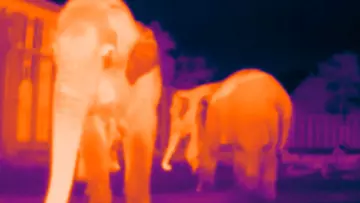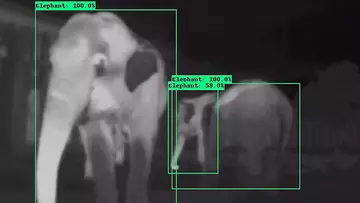Elephant zoo conservation
Our Zoo Research Officer Lewis Rowden and conservation technology specialist Alasdair Davies of the Arribada Initiative - a close Zoo partner - explain how the elephants at our Zoo are helping to tackle human wildlife conflict in the wild through our innovative HEAT project - co-developed by zookeepers and researchers…
Over the past two years 30,000 thermal images of the elephants at the Zoo have been taken. It’s a huge collection and one that is incredible to look through, but this vast databank also has a vital purpose: helping humans and wildlife to co-exist in rural areas, supporting the survival of threatened species.
Supporting Asian elephant conservation
Asian elephants, an Endangered species, are under increasing pressure in the wild due to habitat destruction through human population growth. As the human population continues to grow, elephants have less space to live naturally and are therefore unfortunately forced into smaller areas and thus ever more conflict events with people each year.

This type of human-wildlife conflict is a major threat to the survival of elephants, as well as many other species across the globe, and at ZSL we have identified this as a key conservation challenge.
In response, we've led the development of an affordable technology solution that uses thermal cameras to identify the heat signature of elephants, spearheading the creation of the HEAT (Human-Elephant Alert Technologies) project.
The camera system is able to detect elephants 24/7 as it can ‘see’ the thermal shape of elephants (even in the dark), sending an alert to people living around elephants so they can avoid any conflict situations. You may wonder how the camera knows what a thermal elephant looks like? This is where the elephants living at our Zoo play a pivotal role.

Our ZSL researchers, working with zookeepers and the Arribada Initiative, set up thermal cameras to collect the tens of thousands of images of elephants needed for the HEAT project to accurately confirm the presence of an elephant.
By collecting lots (and we mean lots) of thermal pictures of elephants, from different distances, at different angles, and whilst the elephants are doing different things (such as reaching up to eat food, swimming in their pool, playing with each other), we've created what is now the world’s largest collection of elephant thermal images.
Elephant thermal technology
By teaming up with Colchester Zoo, African elephants were also photographed and included in the database too. Physical differences between African and Asian elephants mean that it is essential to collect images of both to allow the model to be used globally in the field. All of these thermal photographs have been used to ‘train’ the camera technology to recognise what an elephant looks like by labelling the images collected. At present the model created can confidently identify elephants and people from up to 30 metres away.

It’s an incredible achievement, which has exciting real world implications for both wild elephants and the people they co-exist with in Africa and Asia.
The HEAT project is pushing the boundaries of innovative zoo research, bringing together elephants, keepers, scientists and technologists from multiple zoos to co-develop human-elephant alert technologies that wouldn’t be possible without elephants in zoos – part of important global breeding programmes, but also ambassadors for their species.
The next step is to develop prototype cameras, before working with conservation partners to deploy them in the field. We’re excited to move forward.
How we're leading greater one-horned rhino conservation from the zoo and across the globe.
